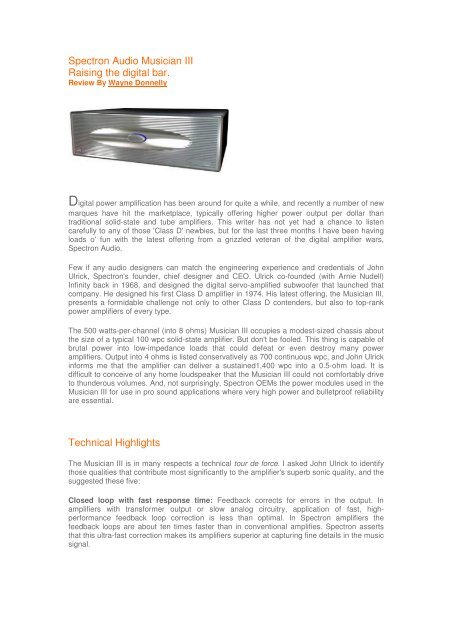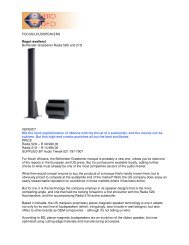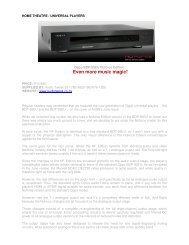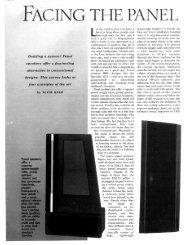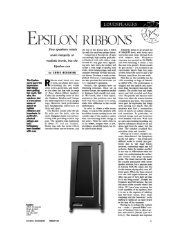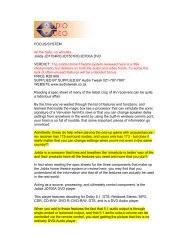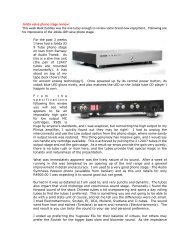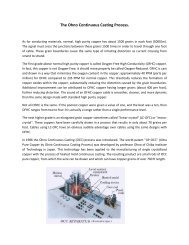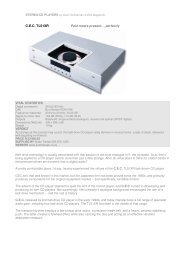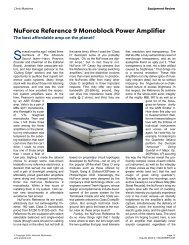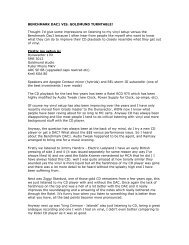Wayne Donnelly - Audio Tweak
Wayne Donnelly - Audio Tweak
Wayne Donnelly - Audio Tweak
Create successful ePaper yourself
Turn your PDF publications into a flip-book with our unique Google optimized e-Paper software.
Spectron <strong>Audio</strong> Musician III<br />
Raising the digital bar.<br />
Review By <strong>Wayne</strong> <strong>Donnelly</strong><br />
Digital power amplification has been around for quite a while, and recently a number of new<br />
marques have hit the marketplace, typically offering higher power output per dollar than<br />
traditional solid-state and tube amplifiers. This writer has not yet had a chance to listen<br />
carefully to any of those 'Class D' newbies, but for the last three months I have been having<br />
loads o' fun with the latest offering from a grizzled veteran of the digital amplifier wars,<br />
Spectron <strong>Audio</strong>.<br />
Few if any audio designers can match the engineering experience and credentials of John<br />
Ulrick, Spectron's founder, chief designer and CEO. Ulrick co-founded (with Arnie Nudell)<br />
Infinity back in 1968, and designed the digital servo-amplified subwoofer that launched that<br />
company. He designed his first Class D amplifier in 1974. His latest offering, the Musician III,<br />
presents a formidable challenge not only to other Class D contenders, but also to top-rank<br />
power amplifiers of every type.<br />
The 500 watts-per-channel (into 8 ohms) Musician III occupies a modest-sized chassis about<br />
the size of a typical 100 wpc solid-state amplifier. But don't be fooled. This thing is capable of<br />
brutal power into low-impedance loads that could defeat or even destroy many power<br />
amplifiers. Output into 4 ohms is listed conservatively as 700 continuous wpc, and John Ulrick<br />
informs me that the amplifier can deliver a sustained1,400 wpc into a 0.5-ohm load. It is<br />
difficult to conceive of any home loudspeaker that the Musician III could not comfortably drive<br />
to thunderous volumes. And, not surprisingly, Spectron OEMs the power modules used in the<br />
Musician III for use in pro sound applications where very high power and bulletproof reliability<br />
are essential.<br />
Technical Highlights<br />
The Musician III is in many respects a technical tour de force. I asked John Ulrick to identify<br />
those qualities that contribute most significantly to the amplifier's superb sonic quality, and the<br />
suggested these five:<br />
Closed loop with fast response time: Feedback corrects for errors in the output. In<br />
amplifiers with transformer output or slow analog circuitry, application of fast, highperformance<br />
feedback loop correction is less than optimal. In Spectron amplifiers the<br />
feedback loops are about ten times faster than in conventional amplifies. Spectron asserts<br />
that this ultra-fast correction makes its amplifiers superior at capturing fine details in the music<br />
signal.
Isolated low-level power supplies: Over the years, some preamplifier designers have gone<br />
so far as to use batteries to achieve isolation from the AC mains. To achieve the same effect,<br />
Spectron employs a micro-sized switching supply for the +15V that operate the low-level<br />
amplifier and the digital logic. This design is about 500 times more isolated than the<br />
conventional method of taking power from a 50/60Hz transformer. As a result, the new<br />
Spectron amplifiers are far less in need of power conditioning or premium power cords in<br />
order to sound their best.<br />
Floating RCA inputs: Ground loops have always been a problem in audio. They may show<br />
up as obvious buzz from speakers with no music playing, or as more insidious hum that rises<br />
with increasing loudness. Even when masked by the music, this hum can make music sound<br />
less natural and detailed. The Musician III's balanced XLR inputs are not susceptible to<br />
ground loops. When connected via single-ended interconnects, the Musician III's floating RCA<br />
inputs eliminate ground loop buzz and hum.<br />
Power capacitors: To store energy between each cycle of power from the 50/60 Hz power<br />
lines, all amplifiers use energy-storage capacitors. Most amplifiers have one big capacitor for<br />
the + supply and a second for the - supply. The Musician III uses separate banks of<br />
capacitors for the left and right channels, emulating a dual mono topology. Those banks of<br />
small capacitors provide a lower-impedance supply to each amplifier module than one big<br />
capacitor can achieve.<br />
High-output voltage and current: A power amplifier's ability to drive loudspeakers is based<br />
on its supplying ample voltage and current. When the amplifier runs out of voltage, it voltage<br />
clips; when it runs out of current, it current clips. With the Musician III's very high peak voltage<br />
of 110 volts and peak current of 50 amps, neither voltage nor current clipping is likely in a<br />
home music system. Despite numerous excursions into unwisely loud listening levels during<br />
the review period, I was never able to push the Musician III into audible clipping.<br />
In addition to the preceding highlights, there are a couple of other features that distinguish the<br />
Musician III from most other power amplifiers. Any audiophile who has ever shorted out a big<br />
amplifier knows what a heart- sickening phenomenon it is — likely to involve loud pops,<br />
electrical flashes and smoke, followed by deadly silence and lingering bad smells. The<br />
Musician III is blessedly immune to such destructive blowups — a comforting thought when<br />
running such high power into your precious loudspeakers.<br />
With the fold-back current limiting implemented in the Musician III, if the amplifier is<br />
overdriven to the 50-Amp peak current limit, it will continue to deliver 50 Amps for half a<br />
second. It then automatically reduces the output current to 15 Amps over the next half<br />
second, and maintains the 15 Amps until the load returns to normal. The practical effect is<br />
that shorting out the Musician III won't hurt it. And if you have "amp-killer" speakers — like the<br />
infamous Infinity Kapa 9s, which go below one-ohm impedance — you can play them loudly,<br />
and you probably won't even hear when the current limit kicks in. The Musician III won't just<br />
shut down at too-high current levels as other amplifiers do.<br />
Unique to Spectron is the Remote Sense speaker cable system, which is designed to<br />
eliminate sonic degradations caused by the musical signal passing through various types of<br />
loudspeaker cables. For $595/pair, Spectron supplies special four-conductor cables; two<br />
conductors carry the musical signal, while the other two feed back to the amplifier output<br />
terminals. They connect to the amplifier via twist-to-connect SpeakON connectors.
The concept here is to extend the amplifier's global feedback network in order to correct<br />
signal errors all the way out to the end of the speaker cables — in contrast to all other<br />
amplifiers, whose control of the signal ends at the cable. Unfortunately, I was unable to<br />
thoroughly evaluate this feature in time for this review. I will publish a follow-up in the near<br />
future to address the comparative performances of Remote Sense versus conventional<br />
premium loudspeaker cables.<br />
In addition to all of the features described above, the Musician III incorporates fault sensing<br />
(of excessive DC or high-frequency output) protection and reset, over/under voltage<br />
protection, and thermal shutoff and recovery. In short, the brute power of this amplifier is well<br />
fortified against virtually any possible malfunction.<br />
Exterior Tour<br />
The silver-toned fascia features horizontal grooves and an oval-shaped, blue backlit center<br />
portion. The on/off pushbutton at the lower left is the only front control. The rear panel<br />
comprises the fault indicator and reset, the IEC jack, and for each channel one set each of<br />
XLR and RCA input jacks, one set of the terrific-sounding Eichmann 5-way speaker terminals,<br />
and one SpeakON connector. There are also two pairs of switches, for selecting the desired<br />
input and for reversing the amplifier's phase. Everything is clearly marked and well laid out.<br />
Review Setup<br />
Most of my time and energy from Spring 2005 to the present has been taken up with<br />
transplanting my life from suburban Mountain View, California to Chicago's South Loop. This<br />
review is my first to be based entirely on the excellent listening room of my new home, a<br />
spacious 12 th -floor condo in an 1891-vintage building. My system now resides in a 23' x 15' x<br />
9 1/2' room with hardwood floor over 12" of concrete (same for the ceiling). Happily, it is<br />
proving to be a fine space for a good audio system.<br />
The Musician III has been auditioned for three months in my reference rig: VTL 7.5 line<br />
preamplifier, Modwright/Denon 3910 all-format player (review coming), Thor TA-3000 Mk II<br />
phono stage, Basis 2800 vacuum turntable, Graham 2.2 arm/Transfiguration Temper<br />
cartridge, mostly Bybee cables. For the first couple of weeks I listened to Meadowlark Blue<br />
Heron 2 loudspeakers; after that, the Analysis Omega planar/ribbon loudspeakers (also<br />
reviewed in this issue.)
Listening<br />
High-powered amplifiers are familiar ground to this writer. For the last few years, my everyday<br />
amplifiers have been successive iterations of the 750-watt VTL monoblocks. I expected a<br />
quite different sonic presentation from the Musician III, and that proved to be the case —<br />
although the digital amplifier was surprising in several respects.<br />
The Musician III from the beginning exhibited a very wideband, high-speed musical<br />
presentation. That in itself was no surprise. What is surprising is, first, that it sounds more<br />
extended in the high frequencies than any amplifier I have had in this system, solid-state or<br />
tube. And secondly, that extraordinary treble extension is remarkably free of the tonal<br />
brightness, the glare and grain that have marked my listening experiences with so many<br />
transistor amps over the years. The neutrality was so pronounced that it took me a few days<br />
to become accustomed to it. And as the amplifier burned in, that extended but smooth and<br />
relaxed quality grew even more natural sounding. The highs took on a lovely, crystalline<br />
quality, somehow unlike other amplifiers I can recall. Perhaps the closest comparison I can<br />
think of for this degree of tonal purity is with the 55 watt WAVAC MD-805 monblocks I<br />
reviewed last November.<br />
I expected very deep and powerful bass, and half-expected it to be the kind of "slam" I<br />
associate with Krell and a few other marques (and which I tend to find exaggerated). In fact,<br />
the bass of the Musician III has a full measure of low-frequency depth, speed and pitch<br />
definition. Equally as important for me, its scaling of dynamics seems flawlessly accurate,<br />
from bass drum thwack to the triangle's strike and decay, and everything in between.<br />
As I mentioned at the beginning, this is my first review to be based entirely on listening in my<br />
new Chicago music room, which is clearly superior to the room I used for the past 15 years in<br />
California. That factor notwithstanding, I feel confident stating that the spatial resolution of the<br />
Musician III is outstanding. Playing the finale of Mahler's Resurrection Symphony (Michael<br />
Tilson Thomas leading the San Francisco Symphony, soloists and Chorus), the spatial<br />
organization of these gigantic performing forces is more clearly delineated than ever before.<br />
Yes, the chorus are obviously ranged behind and surrounding the instruments. But the depth<br />
of the soundscape is greater than I have heard before on this very familiar recording. In<br />
addition, the placement of individual players — solo oboe firmly in the middle of the orchestra,<br />
trumpets clearly at the rear; soprano and mezzo soloists clearly separated from the chorus,<br />
even when they are all singing together — is uncannily precise. It's as if my listening room<br />
has morphed into Davies Symphony Hall right in front of me.<br />
As I play more and more familiar recordings, I am stunned by how faithfully the ambiance of<br />
each recording venue is captured. I can easily distinguish between closely and distantly<br />
recorded piano, between jazz in a club versus a larger venue. And so forth...
Summing Up<br />
Here is where I typically recap the pros and cons of the component under review and express<br />
my opinion about its value in relation to price and competition. In this case I am hard pressed<br />
to find the cons. I can imagine that some hard-core tube lovers may find the Musician III's<br />
harmonic envelope slightly lean — lacking that sweet second harmonic that tubes do so well.<br />
But I think this amplifier's harmonic presentation is honest and robust, more complete than<br />
most transistor amplifiers I've encountered.<br />
A couple of years back, I most enthusiastically reviewed the massive John Curl-designed<br />
Parasound Halo JC-1 400-watt monoblocks, which I have since regarded as the best solidstate<br />
amplifiers I have experienced. At $6,000 per pair, they seemed to me a great bargain.<br />
Now, after the lapse of time since that review, I cannot say authoritatively that the Musician III<br />
sounds even better, but I think it very likely does. At the least it's a close call. And I have no<br />
qualms about pronouncing the Musician III a tremendous value. Anyone looking for powerful<br />
yet highly refined amplification would be foolish to ignore the Spectron Musician III. I believe it<br />
will serve me well as a standard against which to measure other amplifiers. So I'm keeping<br />
this one. Superior audio indeed!<br />
Specifications<br />
Type: Stereo amplifier<br />
Frequency Response: 20Hz to 20kHz ( ±.1dB) at 8 Ohms<br />
Power: 4 Ohms 700 wpc, 8 Ohms 550 wpc, and 1,400 wpc at 2 Ohms<br />
Maximum Output Current: 50 Amps peak<br />
Max Output Voltage: 110V<br />
Damping Ratio: 400:1<br />
Distortion, THD:


